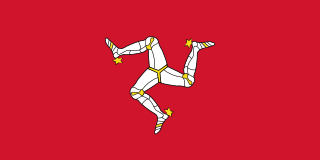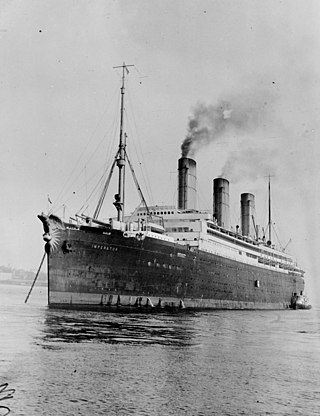
SS Imperator was an ocean liner built for the Hamburg America Line, launched in 1912. Although in Europe, with the exception of Italy and France, all ships are usually referred to as feminine, during the Liner’s Hamburg American Line career the ship was to be referred to as masculine at the special request of Kaiser Wilhelm II. At the time of his completion in June 1913, he was the largest passenger ship in the world by gross tonnage, surpassing the new White Star giants, Olympic and Titanic.

MV The Second Snark is a small passenger ferry, built in 1938 by William Denny of Dumbarton, now operated by Clyde Marine Services on the Firth of Clyde, Scotland.

The TSS Duke of Lancaster is a railway steamer passenger ship that operated in Europe from 1956 to 1979, and is currently beached near Mostyn Docks, on the River Dee, north-east Wales. It replaced an earlier 3,600 ton ship of the same name operated by the London Midland and Scottish Railway company between Heysham and Belfast.
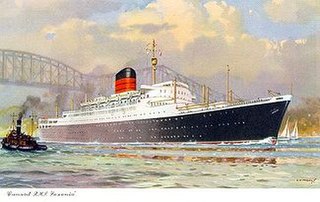
RMS Saxonia was a British passenger liner built by John Brown & Company at Clydebank, Scotland for the Cunard Steamship Company for their Liverpool-Montreal service. She was the first of four almost identical sister ships built by Browns between 1954 and 1957 for UK-Montreal service. The first two of these ships, Saxonia and Ivernia were extensively rebuilt in 1962/3 as dual purpose liner/cruise ships. They were renamed Carmania and Franconia respectively and painted in the same green cruising livery as the Caronia. Carmania continued transatlantic crossings and cruises until September 1967 when she closed out Cunard's Montreal service. She and her sister had been painted white at the end of 1966 and from 1968 Carmania sailed as a full time cruise ship until withdrawal after arriving at Southampton on 31 October 1971. In August 1973 she was bought by the Soviet Union-based Black Sea Shipping Company and renamed SS Leonid Sobinov. The ship was scrapped in 1999.
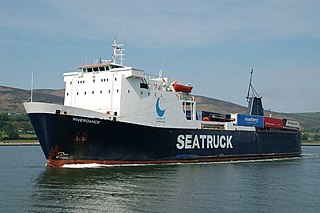
Riverdance was a RORO ferry in service with Seatruck Ferries on the Irish Sea. On 31 January 2008 she was hit by a wave that caused her cargo to shift and she beached at Blackpool, very close to the boundary with Cleveleys. Large amounts of the ship's cargo was spilled overboard after the ship ran aground, resulting in much of it being salvaged by members of the public. Attempts to refloat her failed, and she was scrapped on site during 2008.
Seatruck Ferries is a UK-based freight-only ferry company which commenced services in 1996. It is part of the Clipper Group, a shipping company based in The Bahamas. The company operates out of four ports on the Irish Sea, including Heysham and Liverpool.
The Duke of Argyll was a railway steamer passenger ship that operated in Europe from 1956 to 1975.

The Duke of Rothesay was a railway steamer passenger ship that operated in Europe from 1956 to 1975.
The Duke of York was a steamer passenger ship initially operated by the London Midland and Scottish Railway which saw service from 1935 to 1964. She was renamed HMS Duke of Wellington for the duration of World War II.

TS Duchess of Montrose was a Clyde passenger steamer, built in 1930 for the Caledonian Steam Packet Company. She was a popular boat, providing day cruises until 1964.

SS (RMS) Victoria was a packet steamer originally owned and operated by the South Eastern and Chatham Railway Company, who sold her to the Isle of Man Steam Packet Company in 1928 for the sum of £25,000.

The passenger steamer SS Peel Castle was operated by the Isle of Man Steam Packet Company from her purchase in 1912 until she was sold for breaking in 1939.
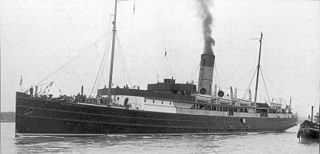
The packet steamer SS Rushen Castle was operated by the Isle of Man Steam Packet Company from her purchase in 1928 until she was sold for breaking in 1947.

SS or RMS The Ramsey was a passenger steamer operated by the Isle of Man Steam Packet Company from 1912 to 1914. She had been built in 1895 as Duke of Lancaster for the joint service to Belfast of the London and North Western Railway and Lancashire and Yorkshire Railway companies. The steamer was requisitioned by the Admiralty in 1914 as the armed boarding vessel HMS Ramsey and sunk the following year.
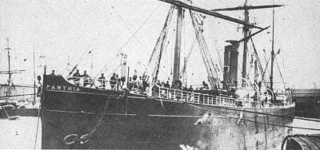
The SS Parthia (1870–1956) was an iron-hulled transatlantic ocean liner built for the Cunard Line by William Denny and Brothers in Dumbarton, Scotland. Her sister ships were the Abyssinia and Algeria. Unlike her two sisters, Parthia was smaller, built in a different shipyard and had a slightly different funnel arrangement. The Parthia was retired by Cunard in 1883 and sold to John Elder & Co., who subsequently transferred her to the Guion Line. After serving with the Guion Line and operating on transpacific routes with the Canadian Pacific Railway Company, she was refit and renamed Victoria.







